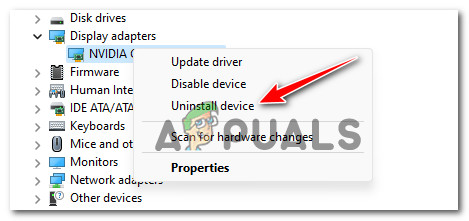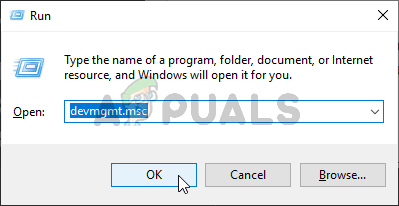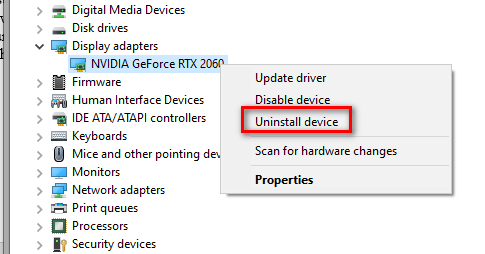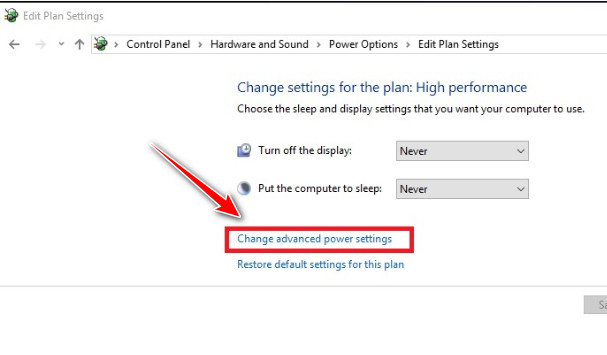After we’ve investigated this particular issue thoroughly, we realized that there are actually multiple causes why you might see this behavior occurring with your Windows 10 PC. Let’s take a look at all the possible culprits that might be triggering this problem: Now that we went over every potential reason why you might experience this problem, go over every confirmed fix and apply them locally until you found a method that resolves the issue for you for good,
1. Boot in Safe Mode & update the display adapter driver
As it turns out, a corrupt display adapter driver is often responsible for causing this particular issue on Windows 10 and Windows 11 installations. If this scenario is applicable, you should boot your PC in safe mode and see if the issue stops occurring. In case your monitors operate normally while you boot in safe mode, chances are you’re indeed dealing with a corrupted display adapter driver. In case you find that the problem doesn’t occur in safe mode (while the generic windows display driver is loaded), you should go ahead and uninstall the currently active display adapter driver in order to force your Windows installation to use a generic equivalent. For step-by-step instructions on enforcing this method, follow the guide below: In case this method didn’t allow you to fix the issue and your monitor/s are still turning off after the initial boot, move down to the next method below.
2. Reinstall the GPU driver + dependencies
In case booting in safe mode and reinstalling the display adapter didn’t fix the issue, you should turn your attention toward the remaining components of your GPU driver. According to some affected users, this problem might also be caused by some associated graphic driver dependencies. If this scenario is applicable, you should be able to fix the problem by completely uninstalling the GPU driver (along with every associated dependency) before reinstalling the latest version from scratch. It’s important to ensure that you remove any remnant files from the old GPU driver installation before reinstalling it. Follow the instructions below for specific instructions on how to do this: Note: You can skip steps 1 to 6 if you already followed Method 1. If the problem is still ongoing, move down to the next method below.
3. Disable Fast Startup (if applicable)
The Fast Startup feature on Windows 10 is notoriously known for causing this type of issue particularly when the CPU is left in idle mode for too long. Dozens of users are reporting that they managed to fix this pesky issue by going into the Power Options menu and disabling the Fast Startup option. Note: This method is confirmed to be effective on both Windows 10 and Windows 11. If you currently have the fast startup option enabled, follow the instructions below to learn how to disable it from the Power Options menu and see if this addresses the monitor turning off issue: If fast startup was already turned off or disabling it didn’t fix the monitor issue in your case, move down to the next method below.
4. Use new monitor cables
If none of the methods above have proven to be effective in your case, you’ve already gone through the majority of driver-related issues that might cause this type of behavior to occur on Windows. Before you move forward, you should take the time to ensure that all your monitor cables are working as intended. Note: According to some affected users, in their case, the monitor display was interrupted due to a non-congruent cable. If you already tried replacing your cables and the issue still occurring, move down to the next methods below.
5. Disconnect non-essential devices
This type of behavior on Windows 10 and Windows 11can also be associated with an inconsistency indirectly caused by devices connected via front-panel ports (wireless keyboards, hard drives, printers, USB hubs, etc.) Some users have found that immediately after they disconnected certain unnecessary peripherals their monitors stopped turning off at random intervals. In some cases, the issue went away after they disconnected an external HDD / SSD, while others got success by disconnecting their USB-powered headset. It seems that you might be dealing with an I/O (input/output) issue or it might be a classic case of an insufficient PSU (Power Source Unit) that’s unable to supply enough power for every component that’s currently connected to your PC. You’d think that the monitor should not be affected by this since it has its own power cable connected externally. That’s true, but the display issues as almost likely caused by the fact that your GPU doesn’t have enough available power bandwidth. Important: If you don’t want to upgrade your PSU to a new unit with a bigger capacity, our only option is to disconnect every non-essential device that’s currently utilizing energy supplied by your PSU. If you already tried removing every non-essential device that’s connected to your PC and you’re still facing the same issue with your monitors, move down to the next method below.
6. Restore default power schemes (if applicable)
If you previously modified the default power plans and customized them to fit your own needs, this might have the unintended consequence of interrupting power to your external monitors. Several affected users dealing with the same kind of monitor issue have confirmed that in their case, the monitors turned off due to a power plan setting. The best way of fixing this issue is to simply revert the changes you made to the default power scheme and only keep your custom settings that won’t affect your monitor. But if that’s not an option for you, you can go for the nuclear option and open a CMD prompt from which you can run a ‘powercfg‘ command that will automatically restore the default scheme. If you’re looking for specific instructions on how to do this, follow the steps below: If the problem is still not fixed, move down to the next method below.
7. Use DVI instead of HDMI or vice-versa (if applicable)
If you’re using a monitor that has both HDMI and DVI prompts, try connecting it to your PC using the alternative slot. Several affected users have confirmed that their monitors stopped turning off at random intervals after boot once they used the different connection option.
In case you currently have it connected via HDMI, use the DVI option instead. If you’re using a DVI connection, connect it using a HDMI cable instead.
Note: In case your monitor only supports HDMI or DVI, skip this method altogether and move down to the next method below.
8. Disable hybrid Sleep (if applicable)
Another power option that is often reported for causing monitor issues like this one is hybrid sleep. Note: Hybrid sleep is a power state that combines sleep and hibernate. When you utilize this feature, your OS will write all it’s RAM to the hard drive or SSD, then goes into a low-power state that keeps the RAM refreshed. While this option is good in theory, a lot of Windows users are reporting that it ends up cutting the display to their secondary monitors whenever their PC is left is idle mode for too long. Once this problem occurs, the only way to get the display back is to restart the PC. If you want to prevent this from occurring in the future, you’ll need to access the Power Options screen and modify the default power settings in order to disable hybrid sleep. For step by step instructions on how to do this, follow the instructions below: If the problem is still ongoing or hybrid sleep was already disabled, move down to the next method below.
9. Performing a Memtest
According to other affected users, this monitor issue might also be related to your RAM component. It’s possible that one or both of your RAM sticks are beginning to fail – in this case, our recommendation is to perform a MemTesy86 stress test and see if you’re currently dealing with some hardware issue affecting your memory. In case you suspect that you memory might be causing this issue, follow the instructions below to deploy a MemTest86 stress test: If the stress test came out clean, move down to the final method below.
10. Take your PC to a technician
If none of the methods above have proven to be effective in your case, it’s clear that you’re dealing with some kind of hardware issue. If you don’t have the know-how to investigate each component individually, the best course of action is to take your PC or laptop to a certified technician and ask him/her to investigate. Additionally, if you have a spare monitor, you should also replace the one that’s causing issues and see if the display interruption stop.
Fix: Windows 11 Won’t Boot After Enabling Secure BootFix: Windows Update Keeps Turning OffHow to Fix a PS4 (PlayStation 4) Turning Off By ItselfFix: Webcam Keeps Turning Off and On Again












